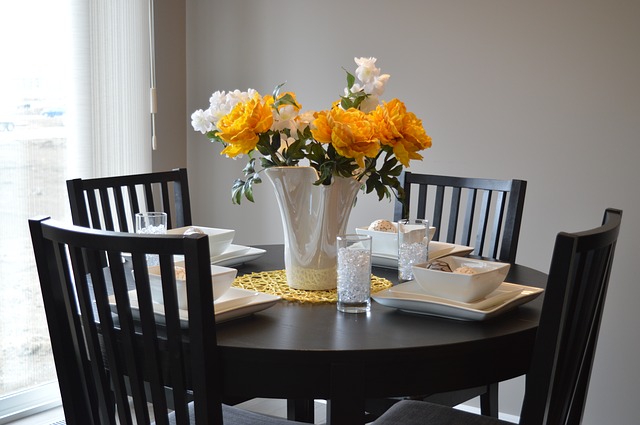 My home office used to be on the second story of my house. It was in a strange, small bedroom with slanted ceilings. There was no good place for the desk and the only window was in a narrow dormer. I always felt awkward in that room and was never inspired.
My home office used to be on the second story of my house. It was in a strange, small bedroom with slanted ceilings. There was no good place for the desk and the only window was in a narrow dormer. I always felt awkward in that room and was never inspired.
When I learned about feng shui I understood why I had a challenging time working in that room. And part of it had to do with a feeling of isolation.
Feng shui is the ancient art of placement and one of its major tenets is the theory of yin and yang. At a basic level, yin and yang represent complementary opposites, such as loud/quiet, active/restful, or public/private. For good feng shui it is vital to consider the proper balance of yin and yang in the space.
The Intimacy Gradient
Architects use the term intimacy gradient which was coined by Christopher Alexander in his design bible, A Pattern Language: Towns, Buildings, and Construction. Intimacy gradient refers to design placement in relation to the amount of intimacy desired for users of that space. The goal is to have a balance of yin and yang energy that is conducive to the goals of that area.
Good design, according to this idea, requires public rooms, such as a living room and dining room, to be at the front of the house and more private rooms (bedrooms and bathrooms) to be placed in the back. Since the front of our homes typically face the road they are subject to increased activity and are more visible to the public; and the back of our homes is typically more protected from view and activity and therefore more restful.
The concept also applies to multi-level homes. The first floor should be more public (receiving foot traffic), whereas subsequent floors should be more private (receiving less foot traffic). Traditional Japanese homes are still designed with this cascade of intimacy from front to back. In fact, the better-designed homes in the U.S. also follow these “rules.”
Now, back to my office and why I hated it.
For most people, myself included, their work requires a need to feel expansive and connected to others. My office did the opposite. Being upstairs, it was too yin; it was too restful and protected which was not a bonus in my work.
When I founded my feng shui practice, I moved my office to the first floor and front of the house which gave me the yang, energetic space that I craved. This room was the living room, which, up until then, was not really used.
Balancing yin and yang contributes to a feeling of harmony. A space that is too yin will eventually contribute to feeling tired and lazy. A room that’s too yang will eventually make us feel anxious and stressed. But each room’s yin-yang balance is different. Let’s review some of the main areas of our homes and what we can do to balance the energy.
Tips for Balancing Yin-Yang Room Placement
Foyer, home office, living room and dining room – These rooms are best in a “yang” area, such as the first floor and/or front of house. If they are in a “yin” area of the house, we can see if we can move rooms around. I have found that moving a home office to a more yang space makes a significant impact on their career and work because the energy is more suitable to this function.
If we cannot move to a better place in the house, we can change the décor a bit to “yang up” the room. Some ideas are the use of bold colors on the wall and/or furnishings, hang a mirror, or add plants. Remember, you want to visually make the room more energetic and expansive. Be creative.
The Kitchen – The kitchen is typically the heart of the home to most people. It is where we prepare meals and eat together as a family. It also is a place for informal entertaining for enjoying a cup of coffee with a friend. It represents nourishment and health. It is best to have this room located at the back of the house.
Family room – A family room is a bit more intimate than a living room and should be at the back of the house. Our culture has become more informal, so we often gather in our family rooms with friends and if there is a living room it is rarely, if ever, used.
Bedrooms and bathrooms – These are the most intimate of rooms. In most multi-level houses, the bedrooms are located on the second level and are more yin. In some more modern floor plans, bedrooms are located nearest to the street, which makes them more yang and are not conducive to rest and relaxation.
What do you do if your layout is different than the best feng shui plan?
If we cannot move our bedroom (and there are few floor plans that can accommodate this change) we can at least make the room more yin. Yin elements are those that are soft, quiet, and dark which promote rest. You can add window treatments that cover the visibility from the street, area rugs and lush fabrics to soften the sound, candles or lower-wattage bulbs to create a softer ambiance, as well as limit the electronics in the room (which are very yang).
It is best not to have a bathroom door near the entrance to a home, which makes it very yang. Bathrooms are better at the back of a home or on another floor. If your bathroom is too yang, warm it up with wood, soft colors, a plant, and lush towels.
Open-concept floor plans can be challenging in this respect. Some homes still have a foyer and living room that is available for less-intimate guests. If your home is all one large space, you can create some intimate spaces and privacy with tall plants or moveable room dividers.
Intimacy in our homes is absolutely vital in order to create a feeling of sanctuary from the modern stressors of life. We can use the ancient concept of yin and yang to help us create homes that we love!

